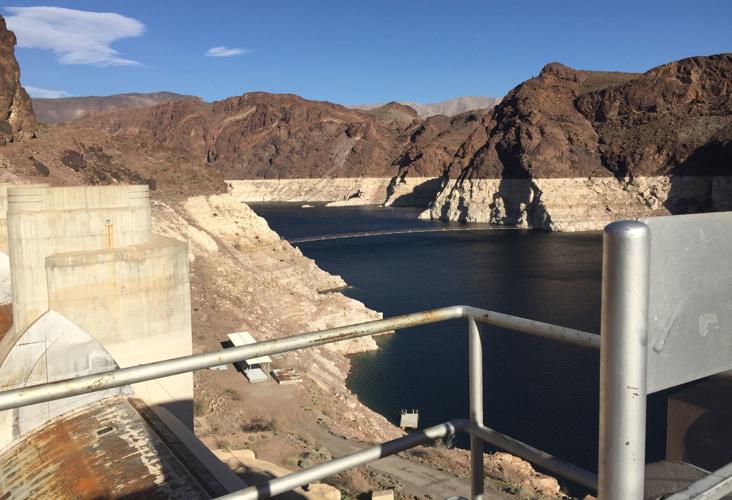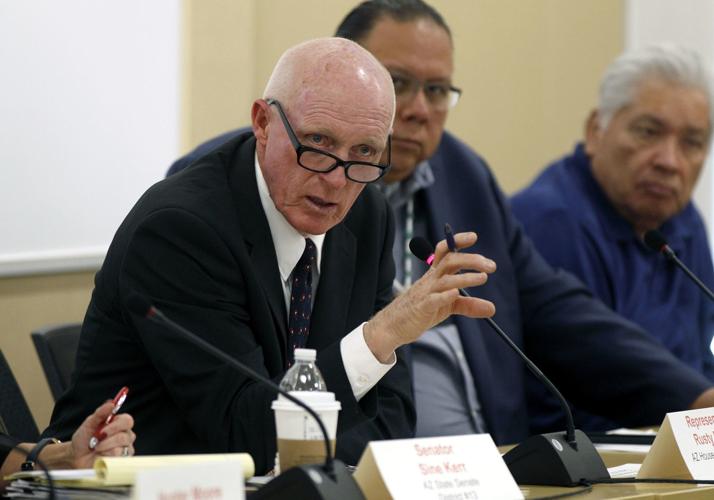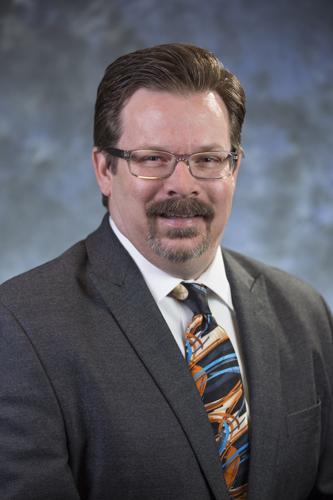Up against a federal deadline to approve a Colorado River drought plan — a “generational change” in Arizona water management — four key legislators say they’re optimistic they’ll meet it.
Led by House Speaker Rusty Bowers, a Mesa Republican, they see the Legislature as ready — finally — to officially endorse the plan. That’s even though competing water interest groups still have highly visible disagreements about it.
From the opening day of its 2019 session on Monday, Jan. 14, the Legislature has until Jan. 31 to pass a resolution putting its stamp of approval on the plan. (Related story, Page C1.)
Otherwise, the U.S. Bureau of Reclamation will launch a legal process lasting seven months that would likely trigger a formal, federal management takeover of the Colorado River — which provides 40 percent of Arizona’s water supply.
Besides Bowers, the optimism comes from three legislators who sit with him on a 40-member Steering Committee representing water users that’s hashed out the details of the plan in eight public meetings since July.
They are Sen. Sinn Kerr, a Buckeye Republican who chairs the Senate Water and Agriculture Committee; and Democrats Sen. Lisa Otondo of Yuma and Rep. Rosanna Gabaldon of Sahuarita, who also sit on committees dealing with water.
Also, officials representing Phoenix-area cities, Pinal County farmers and Arizona Indian tribes are optimistic about the plan’s legislative prospects, despite four unresolved issues that surfaced at last Tuesday’s Steering Committee meeting. The disputes are about a very small portion of the plan, they say.
Another reason the lawmakers feel good about their prospects is that many other legislators are now well aware of Lake Mead’s steadily declining levels, the 19-year drought we’re in and the strong likelihood of much more severe cuts in water deliveries in the near future if the plan isn’t enacted. A third factor is last month’s warning from Reclamation Commissioner Brenda Burman of the potential federal takeover, the legislators said.
“I think we’re on track to get there in time. But if we don’t make it, if it’s not on the 31st, it will be the 32nd,” Bowers said Wednesday in an interview. “We’re going to get there.”
At the same time, Bowers acknowledged it will take work to bring legislators up to speed, particularly with a large number of freshmen who will be seated Monday. He and other legislators have organized three closed-door sessions in which Arizona Department of Water Resources (ADWR) and Central Arizona Project (CAP) officials will lay out details and issues for all interested legislators. The first session of what Bowers calls “Water 101” was held Friday.
“I don’t live in a world without hiccups,” the House speaker said. “I have to plan for them. I have a bunch of freshmen who know nothing about water. You are asking them to make a generational decision. I’m going to do as much as I can to get them some background on this issue, so they can understand the gravity of it and how it will change the law of the river from now on.”
Senate President Karen Fann, a Prescott-area Republican who doesn’t sit on the Steering Committee, told a radio interviewer on Jan. 4, “I think we’re 90 to 95 percent there.”
“There are still some concerns with ag people and homebuilders associations. If we can just iron out those last details we’ll be good,” Fann told Tucson talk show host Bill Buckmaster.
“I’ve been working on water issues up here 30 years,” said Fann, a former Prescott councilwoman and Chino Valley mayor. “I totally understand how delicate it is. I think we are going to get it done. We just have to be positive.”
cuts possible in 2020
The “generational decision” of which Bowers spoke would be for state officials to accept for the first time a formal reduction in Arizona’s river water supply.
Approval of the drought plan will amount to a formal acknowledgment that the Colorado River — which has fueled and supported Arizona’s growth and development for decades — can’t forever supply this state with all the water to which Arizona has clear legal title.
As the proposed drought-contingency plan stands, Arizona would start relinquishing some supplies as soon as 2020, when the federal government now expects to declare the first shortage on the Colorado River.
At first, Arizona would lose about one-third of its CAP supply that serves Tucson, Phoenix and Pinal County farmers. The cuts would grow to nearly one-half that supply by the middle 2020s.
CAP’s governing board and the ADWR have endorsed the plan. The Steering Committee appears to support most of its details.
But at last week’s committee meeting, divisions erupted over two unsettled issues.
One was a request by Pinal farmers for two extra years of 105,000 acre-feet of CAP water once shortages begin. The proposed plan provides that if the river is having bad years in 2021 and 2022, farmers would get 70,000 and 53,500 acre-feet of CAP water respectively, after getting 105,000 in 2020. One acre-foot is enough to cover a football field a foot deep in water.
Farmers say they won’t support the drought plan in the Legislature without assurance of 105,000 acre-feet each year. Even with that amount, they say they’re expecting to fallow 40 percent of their farmland.
Tucson Water is offering to have that amount of its CAP supply delivered to the Pinal farms those years. In return, the city utility would get credits from the state — allowing it the right to pump groundwater somewhere else — for putting the CAP canal water onto farmland so that the farmers don’t pump groundwater. Tucson Water wants to be able to transfer such credits from Pinal County to the Tucson area so it can pump extra groundwater here.
Tucson Water is also seeking several changes in state law that would give Tucson more and/or firmer credits for recharging the aquifer with effluent dumped from sewage-treatment plants into the Santa Cruz River.
Among the most controversial of the changes Tucson Water wants would grant credits to the city allowing it to pump 95 percent as much groundwater as it recharges through effluent in the Santa Cruz. Today, under state law, it only gets credit to pump 50 percent as much groundwater as it recharges through the effluent.
These and other changes provide additional certainty for Tucson’s long-term water supply, Tucson Water Director Tim Thomure said in an email to the Star.
The proposal won’t hurt any other water users, Thomure told the Steering Committee.
ADWR Director Tom Buschatzke praised these proposals as creative. But Bowers questioned whether their impacts should be limited to the Tucson area instead of statewide. Existing laws encourage more effluent and other water supplies to be kept in the aquifer instead of pumped out, and that’s a good system, he said.
Buschatzke said his department has always wanted to limit credits for recharge of effluent to protect the aquifer, but for the drought plan Tucson Water’s request is “something we’re willing to get on board with.”
The second hot issue before the committee is a request from the Central and Southern Arizona Home Builders Associations for 21,000 acre-feet over three years of CAP water for new development, to compensate for losing much more water due to river shortages. The water would be used to replenish aquifers in suburban areas to compensate for groundwater pumped elsewhere to supply new subdivisions.
Opposition erupted to this, because the Gila River Indian Community has already agreed to lease 33,000 acre-feet of its CAP supply for that kind of development the moment the final drought plan is approved by the Legislature.
The builders’ concern is that the Legislature could potentially modify that earlier agreement with the Gila tribe, creating uncertainty about its availability when the builders are seeking certainty, said Spencer Kamps, lobbyist for the Central Arizona Home Builders Association.
The Valley Partnership, a Phoenix-based group representing land developers, joined with the Phoenix Water Department and Gila tribal officials in pointing out there’s no water available to satisfy the builders’ request.
“I think it’s pretty insulting to think we’d walk out on the deal,” Gila tribal attorney Jason Hauter said in an interview.
“Time is not our friend”
Kerr, chair of the Senate Agriculture and Water Committee, said she’s encouraged by overall progress on the plan.
“I expect the Steering Committee to continue to work out the remaining issues and bring a near-consensus plan to the Legislature soon,” Kerr said in an email.
“Our state has an established history of making responsible, albeit tough, decisions to protect our water future. The Legislature has been actively working with stakeholders and is committed to approving a thoughtful resolution,” Kerr said.
Another key legislator, Rep. Gail Griffin, a Sierra Vista Republican, didn’t respond to an email seeking comment on the drought plan. A strong ally of farming interests, Griffin chairs a House committee on water issues.
Another positive factor is that Reclamation Commissioner Burman’s setting of the Jan. 31 deadline has had a “huge, huge effect” on legislators,” Sen. Otondo said in an interview.
“Time is not our friend. We can look at the past Groundwater Management Act and there was a timeline for that, too,” Otondo said, referring to the 1980 threat from the then-interior secretary to halt construction of the CAP canal if the Arizona Legislature didn’t approve a law to rein in then-uncontrolled groundwater pumping.
“These water decisions hurt. Everybody has to feel a little pain,” Otondo said. “But we have to come together and bring forth the best proposal possible. ... Everybody knows that the action has to be taken immediately.”
Money still an issue
But there are some potential uncertainties and glitches ahead, legislators and others said.
For Bowers, it’s coming up with the additional water for Pinal County farmers, even though he’s one of their biggest supporters.
“We’re still a little short. We’re going to need to find a way to come up with a little more money, or shake loose some water out of somebody,” Bowers said, adding that Tucson Water’s proposals may work.
“I just want to get us up to where there is a dependable amount of water out of Pinal County,” he said. “We are asking them to take a big cut.”
For Rep. Kirsten Engel, a Tucson Democrat on the Steering Committee, there are questions about rising cost estimates for the farms’ planned switch from Colorado River water to groundwater pumping.
Farmers recently announced it will cost $50 million to drill new wells and build other infrastructure for the Pinal farmers to switch from CAP to groundwater, up from $30 million before.
Irrigation district officials said the estimated cost went up because they realized they will need to drill more wells to supply enough groundwater at peak growing seasons, rather than use a smaller number of wells year-round.
But Engel says of that big a change, “You’ve gotta wonder. Are we just rushing a little too fast here?”
Another skeptic is Alan Dulaney, a former president of the Arizona Hydrological Society and now water policy adviser for Peoria, a Phoenix suburb of about 170,000 people. While he’s impressed with Bowers’ support for the drought plan, he’s concerned about what he sees as builders’ and farmers’ continued requests for more water, money or both.
“The price tag for Pinal has gone up from $30 million to $50 million for their infrastructure. That’s like ‘wait a minute; when is it going to stop?’
“I think cities know where the money is going to come from — the cities. It will come from taxes and increased rates paid by municipal providers. You can’t bleed everyone dry just to save 200 farmers in Pinal County,” said Dulaney.
Some of the funding would come from cities, but the money would also come from farmers and state and federal tax dollars.
Summing up, Engel said: “My question is do we have to have every single detail nailed down by Jan. 31st? Or can we provide ourselves just a bit more room to make sure we’ve got it right?”
No, there’s not a lot of leeway in the Jan. 31 deadline, a top Bureau of Reclamation official said last week.
“The commissioner is serious. She has not backed off the January 31st deadline,” said Leslie Meyers, area manager for the bureau’s Phoenix office.
With no approved plan by Jan. 31, people would simply stop work on the drought plan and start on an alternative, CAP general manager Ted Cooke has said.
“We’d have to go down a new path.”









